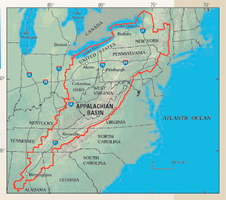 | Back to e-WV
| Back to e-WV
 The West Virginia Encyclopedia
The West Virginia Encyclopedia
 | Back to e-WV
| Back to e-WV
 The West Virginia Encyclopedia
The West Virginia Encyclopedia

Long before our mountains were formed, the Appalachian geosyncline existed as a low-lying basin, mostly to entirely covered by a shallow sea. This continued throughout the Paleozoic Era, from about 570 million to 240 million years ago. The basin continued to subside through that tremendously long stretch of time, and to receive sediment from adjacent lands to the west and east. The lands to the east were the dominant source of sediment to the subsiding basin (geosyncline), as those lands were being intermittently raised by continental collisions between the North American and European-African plates; this uplifting accelerated erosion. With time and the tremendous pressures of burial and later mountain building, the thousands of feet of sediment became rock, containing the great mineral wealth of today’s Appalachia.
The size of the Appalachian geosyncline fluctuated somewhat during the 330 million years of its existence, but generally it ranged from what is now New York in the north to Georgia and Alabama in the south. The Appalachian Basin encompasses much of present Pennsylvania and Maryland, all of West Virginia, and parts of Ohio, Virginia, Kentucky, and Tennessee. The geologic strata that occur in that area were deposited as sediments of mud, sand, silt, lime muds, and peat that today are sedimentary rocks such as sandstone, siltstone, shale, limestone, and coal beds.
The sedimentary rocks deposited in that widespread, long-enduring basin contain considerable mineral deposits and fossil fuel deposits. The term ‘‘Appalachian Basin’’ is commonly used among fossil fuel prospectors and developers to refer to the portion of that ancient sedimentary basin that now contains those fossil fuels and other minerals such as salt and salt brines. Other sedimentary basins occur in other parts of the United States and around the world, and are the sources of the world’s fossil fuel supplies, along with other important mineral resources.
The mineral resources of the Appalachian Basin were recognized early in the region’s settlement history, and in fact were used to some extent by the native tribes. Natural occurrences of saltwater springs and seeps were used by Indians and early European settlers alike, and natural oil and gas seeps were recorded by early explorers. Coal was dug and used locally by blacksmiths and others before commercial mines were opened. The Appalachian Basin resources began to be developed in earnest in the mid- and late-1800s and fueled the Industrial Revolution in the United States with oil, gas, and coal deposits, including the high-quality coals needed for production of steel.
In West Virginia, the Appalachian Basin produces natural gas, oil, and coal. In 2023, West Virginia was the nation’s second-leading coal producer. The commercial coal beds occur only in strata deposited during the Pennsylvanian Period of geologic time, while oil and gas deposits are found in strata from throughout the Paleozoic Era. The large chemical industry of the Kanawha Valley at and near Charleston originated with development of the natural salt brine deposits.
Written by Ron Mullennex
Janssen, Raymond E. Earth Science: A Handbook on the Geology of West Virginia. Clarksburg: Educational Marketers, 1973.